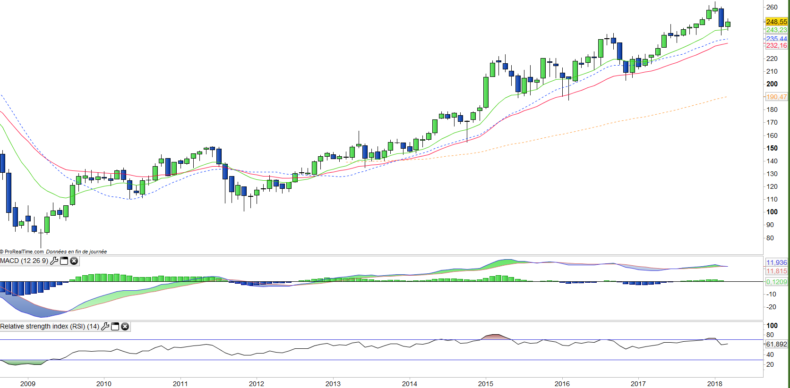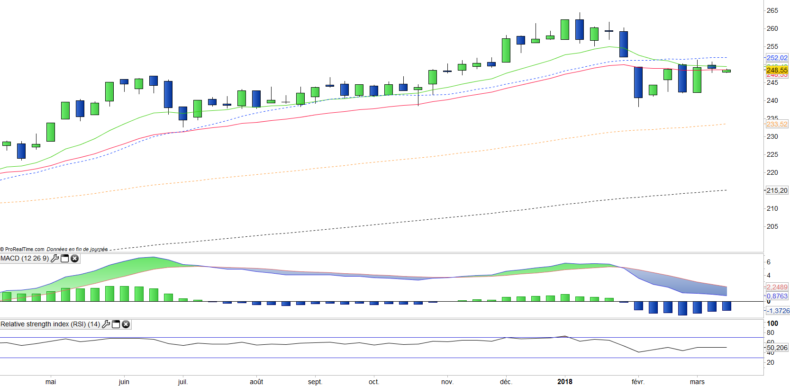BNPP Easy EPRA/NAREIT Eurozone Capped (EEE) - 20/03/2018
Short Term strategy: Positive (90%) / Trend =
Long Term strategy: Positive (95%) / Trend =
Characteristics of the ETF
The ETF BNP-Paribas EEE (Real Estate euro zone) created in 10/2015 in Euro and listed on Euronext seeks to replicate the index FTSE EPRA / NAREIT Eurozone Capped Net Total Return composed of 48 property values of the Euro zone, of which approximately 63 % of German and French holdings.
The fees of this ETF are 0.4% and the AUM of approximately € 720m. Replication is physical and there is a dividend policy.
Alternative ETFs: MEH (Lyxor in Euro), EPRE (Amundi in Euro), EXI5 (iShares in Euro)
Index & components
The objective of the ETF BNP Paribas EEE is to replicate the performance of the FTSE EPRA / NAREIT Eurozone Capped Net Total Return index, which is composed of the main property values representative of the listed real estate sector in the euro zone.
EEE is quite diversified, it is composed of 48 property stocks, of which 32% are German, 31% French and for the rest mainly Spanish (9.9%) and Belgians (8.7%). The top 10 stocks account for around 58% of the index's capitalization, and the top 3 hold about 27%: (Unibail-Rodamco 9.1%), Vonovia (8.7%) and Deutsche Wohnen (7.8%), with market capitalizations between € 13 and € 20bn.
The real estate sector is influenced by many factors, the most important of which is certainly the inflation / interest rate pair. A low rate environment not associated with deflation is very favorable for real estate companies who generally use leverage to buy assets and which are also yield values.
Large listed property companies often seek quality assets, which allow them greater visibility on revenues and a better valuation. The two most represented countries are Germany and France, which offer different but also interesting features. In Germany, the price of assets has risen a lot recently but is cheaper than in France with a high appreciation potential while the dynamism of the German economy is a real asset. Moreover, there is a delay in the construction of housing, compared to the demand that comes in support for prices, as in France. The regulatory framework (eg rent ceilings), taxation and demography are also important factors.
We can distinguish two main businesses for listed property companies, which are residential (eg Vonovia and Deutsche Wohnen) and commercial real estate (eg Unibail-Rodamco), which have different business models with generally better resilience for commercial real estate apart from severe crises. The scarcity of quality assets which restrains organic growth should lead to a consolidation of the sector, especially as the interest rate environment remains extremely favorable. There is also growing diversification in retirement home walls by some actors.
The European property sector remains promising, given the better prospects in the euro zone, particularly in France. However, it is important to pay attention to a possible change in monetary policy of the ECB which could lead to a new upward cycle on interest rates.
Latest developments
The EEE ETF posted a 6th consecutive annual increase in 2017 of 17.6% but has fallen by 3.7% since the beginning of 2018.
The real estate sector is very sensitive to rates and inflation expectations, and the sector was impacted by the theme of the rise in long-term rates in the US and higher expectations of inflation due to full employment, the dynamism of the world growth economy and the rebound of commodities, a move that eventually spread to Europe.
However, fears of a trade war that follow US protectionist actions now counterbalance the risk of overheating, which has allowed the real estate sector to rebound. The sector is also driven by a logic of consolidation, while Klepierre has just been denied an offer on Hammerson (UK) with a premium of 40% the latter judging the offer too low. This suggests that the sector retains strong growth potential beyond macroeconomic considerations and that consolidation is expected to accelerate in Europe.
Monthly data
The monthly chart shows a positive long-term trend that continues unabated despite the consolidation in February, which is not very marked compared to the two previous corrections recorded in 2016 that were halted each time by the EMA26. The month of March shows a gradual recovery of the upward trend that remains to be confirmed. Oscillators also stabilize in the high zone, which is positive.
Weekly data
On the weekly chart, we can observe an hesitation phase around moving averages EMA13 and 26 that threaten to cross downward except if rapid recovery above the EMA20 occur. The short-term situation is uncertain, but is part of a medium-term upward trend as long as the EMA100, which has played the main support role in recent years, has not been broken down. The two limits to monitor are 233 € / 252 €.
ETF Objective
EEE is an ETF quoted in € which seeks to replicate the FTSE EPRA/NAREIT Eurozone Capped (NTR) Index (48 companies)
Characteristics
| Inception date | 21/10/2015 |
| Expense ratio | 0,40% |
| Benchmark | FTSE EPRA/NAREIT Eurozone Capped Net Total Return |
| Code / Ticker | EEE |
| ISIN | LU0950381748 |
| Issuer | BNPP Easy |
| Currency | € |
| UCITS | Yes |
| Exchange | Euronext |
| Assets Under Management | 720 M€ |
| Replication method | Physical |
| PEA (France) | No |
| SRD (France) | Yes |
| Dividend | Distribution (capitalization for EEA) |
| Currency risk | No |
| Number of Holdings | 48 |
| Risk | 3/5 |
Country Breakdown
| Germany | 32% |
| France | 31% |
| Spain | 10% |
| Belgium | 9% |
| Netherlands | 5% |
| Austria | 5% |
| Ireland | 3% |
| Others | 5% |
Sector breakdown
| Diversifié | 32% |
| Distribution | 25% |
| Résidentiel | 24% |
| Bureau | 7% |
| Industrie | 4% |
| Autres | 8% |
Top Ten Holdings
| Unibail Rodamco | 9% |
| Vonovia | 9% |
| Deutsche Wohnen | 8% |
| Klepierre | 7% |
| Gecina | 6% |
| Leg Immobilien | 4% |
| Merlin Properties Socimi | 4% |
| Foncière des Régions | 4% |
| Buwog-Gemeinnutzige Wohnung | 3% |
| Icade | 3% |


